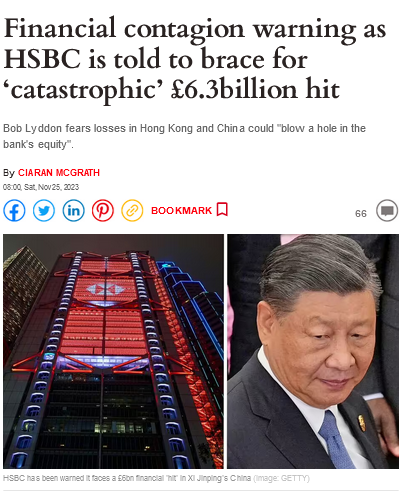Published on 6th December 2023
This is the third and final blog in my mini-series about the exposure of Britsh banks to China, and to Chinese real estate lending in particular.
You can acecss the whole Daily Express article of which the snapshot above is the headline through this link:
I have also done a summary of the numbers which you can download here.
They are a short version of the full analysis which you can access via the second blog in the series.
£3.3 billion of the £6.3 billion loss would arise if HSBC wrote down its 62% stake in Hang Seng Bank by the same percentage – 28% – by which Standard Chartered wrote down its 16.26% stake in China Bohai Bank.
The remaining £3 billion is the amount of commercial real estate loans HSBC has made into Hong Kong that are rated as ‘sub-standard’ or ‘credit-impaired’ in its internal credit risk evaluation system (and these are the fourth and fifth categories out of five in descending order of quality) AND which are unsecured.
Since when was any ‘real estate lending’ UNSECURED? That is not the same as a secured loan upon which the value of the collateral has fallen below the amount of the loan and which, in the context of a residential mortage, is often referred to as ‘negative equity’.
According to the Corporate Finance Institute, ‘Commercial real estate (CRE) lending refers specifically to credit that is created to finance or refinance commercial property’ and in which ‘The common thread among all forms of CRE lending is that physical property serves as collateral to secure the credit exposure’.[1]
This is quite incredible, and one would need to ask numerous stakeholders whether they had appreciated what this disclosure means, such as an investor in HSBC’s shares or debt, or a credit analyst or share analyst, or the auditors, or the financial regulators that check that the bank is holding the right amount of capital for the risks it has taken.
Unsecured lending into real estate, with the Hong Kong market as it is, which is also rated as ‘sub-standard’ or ‘credit-impaired’, should be written off completely as a credit loss. A credit loss of £3 billion on Hong Kong commercial real estate lending might not be enough, though, if there are further problems in the SECURED Hong Kong commercial real estate loan portfolio, and in the mainland China SECURED and UNSECURED commercial real estate loan portfolios.
£3 billion would recognise the egregious departure from what is normally taken to be a ‘real estate loan’ but might not be enough to cleanse the entire portfolio.
With the write-down on Hang Seng Bank added, one has a total ‘hit’ of £6.3 billion to HSBC’s equity. Banks are permitted a minimum relationship of 3% between equity and on-balance sheet assets (like loans). Given banks’ ownership of other assets, few stretch it to 3%, and 5% is a better indicator. If HSBC loses £6.3 billion of equity, it either has to push its so-called ‘Leverage Raio’ nearer to the 3% limit, or dispose of other assets.
Banks’ normal response to something like this is to cut lending, and a cut of £6.3 billion at the 5% rate would necessitate a shrinkage of £126 billion. That could come about anywhere in the HSBC empire.
The more worrying aspect is, if the credit scoring standards are so weak within HSBC’s internal credit risk evaluation system as to have permitted the situation in Hong Kong to arise, what other issues lurk within its global empire? Each loan has to have a reservation of equity against it and the concern is that these reservations may be too low across the board.
If that is the case, HSBC’s static amount of equity may turn out to be good enough only to support a loan volume £200-300 billion lower than the bank currently has. It is then much easier to cut the better-quality loans, because the borrowers can find replacement credit elsewhere. The average quality of the bank’s loans starts to reduce and a tailspin effect threatens.
At any rate this case necessitates a review of banks’ internal credit risk evaluation system, known by the term ‘Advanced Internal Ratings-Based’ methodologies.
[1] https://corporatefinanceinstitute.com/resources/commercial-real-estate/commercial-real-estate-lending/ accessed on 20 November 2023

